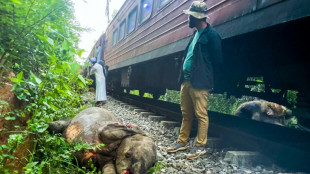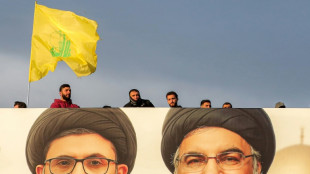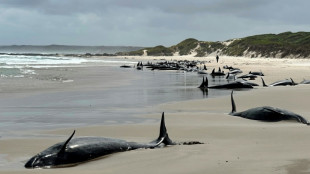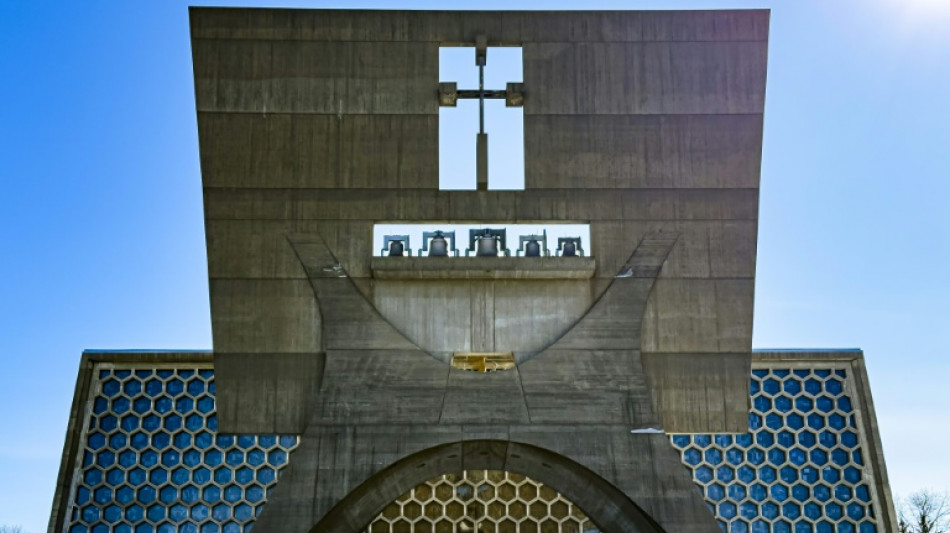
-
 Australia says China has not explained naval live-fire warning
Australia says China has not explained naval live-fire warning
-
On $15 a month, Venezuela's teachers live hand to mouth

-
 Reds boss Kiss hails resilience in 13-try Super Rugby extravaganza
Reds boss Kiss hails resilience in 13-try Super Rugby extravaganza
-
Porn stars: Oscar favorite 'Anora' gets sex work right

-
 Arab leaders meet in Saudi Arabia to hash out Gaza plan
Arab leaders meet in Saudi Arabia to hash out Gaza plan
-
South Africa's Potgieter fires 61 to grab PGA Mexico Open lead

-
 LA prosecutor says opposes new trial for Menendez brothers
LA prosecutor says opposes new trial for Menendez brothers
-
Australia says no live firing seen or heard from Chinese ships

-
 US proposes Ukraine UN text omitting mention of occupied territory: diplomats
US proposes Ukraine UN text omitting mention of occupied territory: diplomats
-
Trump says Zelensky and Putin must 'get together'

-
 AP sues White House officials over denial of access
AP sues White House officials over denial of access
-
Everton boss Moyes doing a better job than me, says Man Utd's Amorim

-
 'See you in court': Trump, governor spar over trans rights
'See you in court': Trump, governor spar over trans rights
-
US stocks tumble on fears of slowdown

-
 Champions Spain fight back in Women's Nations League opener, England held
Champions Spain fight back in Women's Nations League opener, England held
-
M23 pushes deeper in east DRC, UN urges Rwanda forces to leave

-
 Leicester hit historic low in Brentford rout
Leicester hit historic low in Brentford rout
-
LA mayor sacks fire chief over handling of deadly blazes

-
 Suspect arrested after stabbing at Berlin's Holocaust memorial
Suspect arrested after stabbing at Berlin's Holocaust memorial
-
Cuba opens solar park hoping to stave off blackouts

-
 'Super tough' Rublev in third Qatar final, faces Draper for title
'Super tough' Rublev in third Qatar final, faces Draper for title
-
Yankees change facial hair policy to allow 'well-groomed beards'

-
 'History will not forgive' failure to seal pandemic deal: WHO chief
'History will not forgive' failure to seal pandemic deal: WHO chief
-
There's optimism Wembanyama will make strong recovery

-
 Cognac on the rocks: industry seeks French govt help from Chinese tariffs
Cognac on the rocks: industry seeks French govt help from Chinese tariffs
-
Texas measles outbreak reaches 90, mostly unvaccinated

-
 Holders Spain stun Belgium with late comeback in women's Nations League
Holders Spain stun Belgium with late comeback in women's Nations League
-
Man badly wounded in suspected stabbing at Berlin's Holocaust memorial

-
 Ex-Trump aide's 'Nazi ideology' salute sparks French party leader's protest
Ex-Trump aide's 'Nazi ideology' salute sparks French party leader's protest
-
Man found guilty of trying to kill Salman Rushdie

-
 Man badly wounded in assault at Berlin's Holocaust memorial: police
Man badly wounded in assault at Berlin's Holocaust memorial: police
-
USA needs travel reforms to cope with mega sports events: report

-
 World champion Brignone storms to Sestriere giant slalom
World champion Brignone storms to Sestriere giant slalom
-
'Unknown little Englishman' Sherratt hoping to reverse Welsh fortunes

-
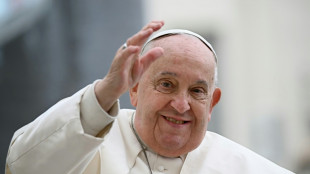 Pope not out of danger, doctors say, amid questions over future
Pope not out of danger, doctors say, amid questions over future
-
Christie's first-ever AI sale angers some artists

-
 M23 advances deeper in east DRC as Congolese troops flee
M23 advances deeper in east DRC as Congolese troops flee
-
German flying taxi start-up's rescue deal collapses

-
 Court of Arbitration for Sport rejects Rubiales ban appeal
Court of Arbitration for Sport rejects Rubiales ban appeal
-
S.Africa wants 'inclusive' talks on ending Ukraine war, invites Zelensky

-
 Postecoglou wants Spurs to 'kick on' after turning corner
Postecoglou wants Spurs to 'kick on' after turning corner
-
Rickelton hits century as South Africa rout Afghanistan in Champions Trophy

-
 Ireland expect 'galvanised' hosts, as Wales try to quiet 'outside noise'
Ireland expect 'galvanised' hosts, as Wales try to quiet 'outside noise'
-
French-Lebanese architect to redesign British Museum galleries

-
 Stock markets diverge, oil prices slide
Stock markets diverge, oil prices slide
-
History inspires Darge as Scotland eye five wins in a row over England

-
 'Queen of Pop' Madonna lambasts 'King' Trump
'Queen of Pop' Madonna lambasts 'King' Trump
-
Apple says halting data protection tool for UK users

-
 Rangers boss Clement not distracted by US takeover reports
Rangers boss Clement not distracted by US takeover reports
-
Andreeva defeats Rybakina in Dubai to become youngest WTA 1000 finalist


How a 'forgotten' Minnesota monastery inspired 'The Brutalist'
On a snowy prairie in Minnesota stands a monastery like no other. A concrete trapezoid banner encasing a bell tower looms over a giant, beehive-shaped front window composed of hundreds of gently shimmering hexagons.
For half a century, the existence of this modernist masterpiece has been mainly known to the Benedictine monks who worship there, and the hordes of architects who make pilgrimages to Saint John's Abbey Church each summer.
But these days, it is finding new fame as the basis for "The Brutalist," the epic drama about an immigrant architect, haunted by the Holocaust, that is a favorite to win best picture at the Oscars.
The tale of the church's genesis is as unlikely as the movie plot it inspired, spanning titans of architecture, ambitious monks, Vatican reform -- and an almighty row over that beehive window.
Giving tours to guests, abbey member Alan Reed begins by asking his guests: "How could this have happened?"
"That this small college at the time, in the middle of nowhere, run by a group of monks, would hire a world-famous architect... it is an amazing story," he told AFP.
- 'Extraordinary' -
It begins with Baldwin Dworschak, a 44-year-old "buttoned-down" abbot, who inherited stewardship of a monastery rapidly outgrowing its historic grounds in the post-war US boom years of the 1950s.
At a time when the Catholic Church was reforming and modernizing, Dworschak and his advisors saw an opportunity to emulate the pioneering 12th-century European monks who ushered in the then-new Gothic style.
Arranged by a monk who had studied architecture, letters inviting commissions were sent out to Richard Neutra, Walter Gropius, Eero Saarinen and Marcel Breuer -- among the world's leading modernist architects at the time.
Amazingly, several responded, and Breuer -- a Hungarian Jew who had trained at Germany's influential Bauhaus school, and invented the sleek, tubular-steel chairs that furnish trendy offices to this day -- was appointed to oversee the giant church in a far northern corner of the United States.
The design he came up with was "something nobody had ever seen before," said Victoria Young, a professor of architecture at the University of St Thomas in Minnesota, who wrote a book on Breuer's "extraordinary" creation.
Chinese American architect I.M. Pei -- a former student of Breuer -- once wrote that Saint John's Abbey Church would be considered one of the greatest examples of 20th century architecture if it were located in New York, not Minnesota.
- Almighty row -
Brady Corbet, director of "The Brutalist," cites a book written by Hilary Thimmesh, a junior member of Dworschak's committee, as a key source for his movie.
Corbet told AFP he has visited Saint John's, and stumbled upon Thimmesh's memoir while doing extensive reading for the film.
Several parallels are clear: a Jewish architect designing a colossal Christian edifice on a remote US hilltop, in a controversial modernist style.
A major source of dramatic tension in the film occurs when the client -- a millionaire tycoon in the movie, rather than an abbot -- brings in his own designer, undermining the original architect.
In real life, Breuer struck up a friendship with Dworschak, but they fell out when the monks brought in their own stained-glass window designer, spurning the work of Breuer's close friend and former teacher Joseph Albers.
In a bitter letter, Breuer calls the move a "sudden blow" and states it would be "better to do nothing" than go ahead with the monks' preference.
The new design must be "terminated immediately," says another letter -- to no avail.
The power struggle in "The Brutalist" culminates in a horrific act of sexual violence in an Italian marble quarry.
Thankfully, the real-life client and architect quickly made up.
- 'Forgotten' -
Some inevitable Hollywood hyperbole aside, an Oscar-nominated film bringing attention to their monastery's hidden treasure is a source of pride for those connected to Saint John's.
Architect Robert McCarter wrote a book on Breuer "because I felt Breuer had been forgotten, even by the profession, to some degree," he told AFP.
"There are many people who think that Saint John's is, by far, his greatest building. That includes me," he said.
"It's still a place that enough people don't know about," agreed Young.
For the monks of Saint John's today, the film could offer a more practical lifeline.
The church is badly in need of repairs, with some concrete starting to crumble, and steel beginning to rust.
Their order has shrunk, from being the world's largest male Benedictine monastery with 340 monks, to below 100. It is far too few for such a cavernous space.
"If we could raise enough money," the monks could at least heat the church in winter and cool it in summer, said Reed.
And the attention the film is getting?
"The monks certainly are quite impressed," he said.
Y.Bouchard--BTB

